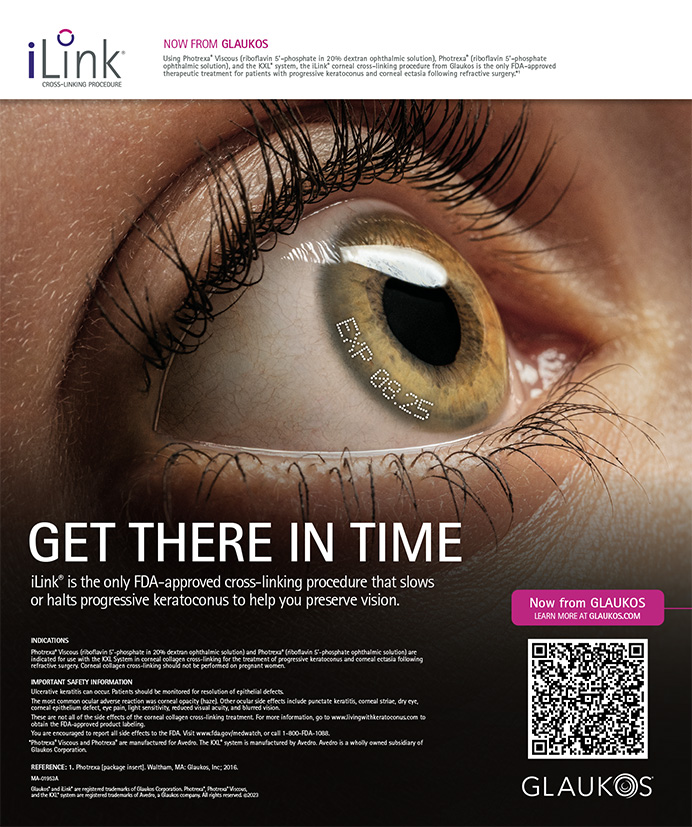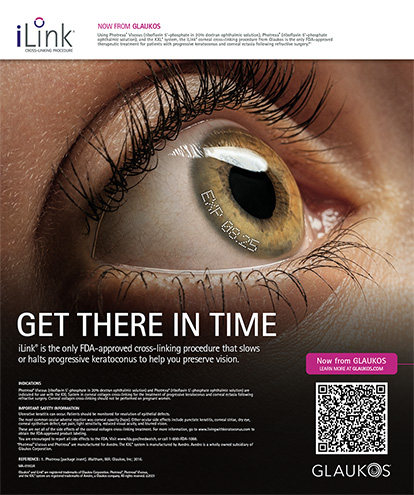
Although common, epithelial basement membrane dystrophy (EBMD) remains an often overlooked and frustrating cause of postsurgical disappointment. EBMD, also known as Cogan dystrophy, a reduplication of the epithelial basement membrane, can cause blurred vision, which may also be associated with dry eye disease and surface irregularity. It often causes shifting changes of the ocular surface, inducing astigmatism and disrupting the precorneal tear film, which explains why patients with EBMD frequently describe fluctuations in vision. This may require multiple adjustments in their spectacle prescription over a short time period.
WHAT IS EBMD?
EBMD is known by another name that describes its physical characteristics. Map-dot-fingerprint dystrophy describes the appearance of coast-like outlines on a map, the microcysts that form as migrating epithelial cells become trapped in the superfluous cell layers, and the whorled fingerprint-like patterns of parallel and thickened duplicate basement membranes that can be seen with the slit lamp. This alternate name also defines the pathologic features of this insidious disease state. Patients with EBMD will generate a new basement membrane much more rapidly than is normal, and it will encroach on the corneal epithelium and disrupt the stroma-to-epithelial junction.
The pathology explains why EBMD is a major risk factor for the development of recurrent corneal erosions. Since the corneal epithelium does not adhere well to the underlying stroma, the epithelial membrane is oft-disrupted, exposing the corneal nerves. Patients may experience sharp, stabbing pain upon waking, as the eyelids part and pull open a small hole or tear in the ocular surface.
DIAGNOSIS AND MANAGEMENT
Because EBMD is a spectrum disease and its findings can be subtle, its true incidence is unknown. Studies have reported rates as high as 40%, with an increasing incidence corresponding to advancing age.1
Any time a patient describes suddenly blurred vision, changes in acuity, and/or multiple changes in his or her glasses prescription, my index of suspicion for EBMD instantly increases. The diagnosis is made by observing the map-dot-fingerprint pattern on slit-lamp examination; if the pupil is dilated, retroillumination is extremely helpful. Negative staining using fluorescein may also reveal negative staining patterns, similar to a topographical map.
The treatment of EBMD typically begins with the use of artificial tears to keep the surface lubricated. Warm compresses help to clear the oil glands, and the additional meibum may help the lids slide better, reducing friction and allowing better adhesion of the superficial layers. The use of fish oil may be helpful, although there are no randomized clinical trials specifically examining the role of omega-3s in EBMD. In more severe cases, mild topical corticosteroids may be indicated, and I have prescribed topical cyclosporine ophthalmic emulsion 0.05% (»Restasis; Allergan) in some cases. For advanced cases, epithelial debridement removes loose tissue; an amniotic membrane graft such as »Prokera (Bio-Tissue) will serve as a scaffold for healthy corneal surface regeneration and cover epithelial defects as they heal.
SURGICAL PATIENTS
In the perioperative period, EBMD is a potential concern, although it is not an absolute contraindication to proceeding with cataract or refractive surgery. If EBMD is suspected, surgery should be delayed until the condition is stable. Due to a propensity for change in the shape of the corneal surface, EBMD is a risk factor for inaccurate biometry and IOL power calculations.
Anterior segment surgeons typically think of EBMD in the context of LASIK surgery due to the well-known risk of epithelial sloughing with subsequent disruption of the postoperative healing process. In this era of premium lens implants, however, EBMD warrants just as much attention in the cataract patient population as it does among those undergoing laser vision correction. The need for precise measurements is of the utmost importance in refractive cataract surgery; however, because EBMD can disrupt the healing process after any procedure, patients receiving standard IOLs may also experience poor refractive results due to undetected EBMD.
CONCLUSION
Anterior segment surgeons often think about optimization of the ocular surface prior to cataract or refractive surgery. To most, this means treatment of dry eye disease to optimize preoperative calculations, which sets the stage for successful surgery. Optimizing the ocular surface also means diagnosing and managing any ocular surface disease, such as EBMD, before beginning the presurgical workup.
EBMD can be easily overlooked, but its relative frequency suggests that a complete examination should be directed to look for the disease’s presence in all surgical candidates. I often take slit-lamp photographs and perform topography to demonstrate the effect of EBMD to patients. I use the analogy of shifting sands on a sand dune to facilitate their education, because I find that this concept helps convey the moving refractive target. Fortunately for patients, available treatment options can help stabilize EBMD, permitting the ophthalmologist to perform successful cataract or refractive surgery.
1. Werblin TP, Hirst LW, Stark WJ, et al. Prevalence of map-dot-fingerprint changes in the cornea. Br J Ophthalmol. 1981;65(6):401-409.
Barry A. Schechter, MD
• director, Department of Cornea and External Diseases, Florida Eye Microsurgical Institute, Boynton Beach, Florida
• (561) 737-5500; baschechter@gmail.com
• financial interest: none acknowledged


